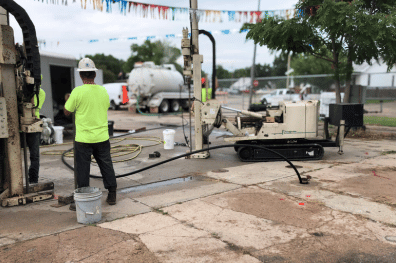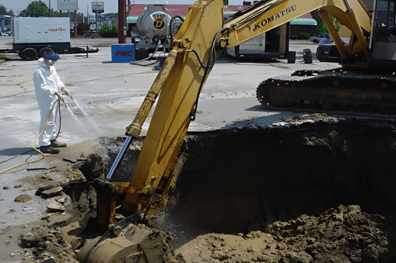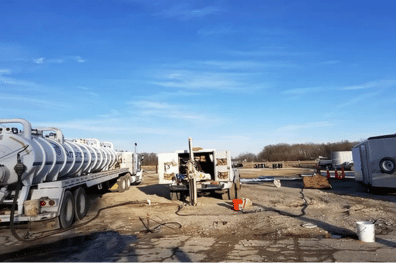ORIN successfully treated BTEX contaminated groundwater utilizing in-situ chemical oxidation. Approximately 70 gallons of catalyzed sodium persulfate at 18-percent solution was injected into each of the forty-two injection points at depth-specific intervals. Each interval received approximately 20-gallons of treatment chemistry.
The injection points were spaced in a grid pattern to treat the contaminant plume. The treatment chemistry injection was coordinated with vacuum extraction on adjacent wells to control hydraulic activity more accurately and to improve injection efficiency. This facilitated preferred treatment chemistry coverage within the targeted treatment area.
The Challenge
The site required precise treatment implementation:
- BTEX contaminated groundwater
- Multiple depth intervals
- Plume distribution management
- Need for long-term effectiveness
- Complex hydraulic conditions
- Treatment coverage verification
The Solution: Integrated Treatment Strategy
The team implemented a comprehensive approach:
- Chemical Treatment Design:
- 42 strategic injection points
- Grid pattern distribution
- Depth-specific targeting
- 70 gallons per point
- 18% solution strength
- 20-gallon interval dosing
- Implementation Methods:
- Catalyzed sodium persulfate
- PermeOx Plus integration
- Synchronized vacuum extraction
- Hydraulic control maintenance
- Coverage optimization
Advanced Implementation
Key operational elements included:
- Strategic grid placement
- Coordinated extraction timing
- Hydraulic activity control
- Treatment efficiency optimization
- Coverage verification
Impressive Results
The treatment achieved multiple objectives:
- 85% BTEX reduction in most contaminated wells
- Successful plume management
- Enhanced treatment distribution
- Ongoing bioremediation support
- Sustained oxygen release
Key Success Factors
Several elements contributed to project success:
- Strategic injection grid design
- Synchronized extraction process
- Precise interval targeting
- Hydraulic control maintenance
- Residual treatment benefits
Innovation Highlights
The project demonstrated several advantages:
- Effective contaminant reduction
- Controlled treatment distribution
- Long-term remediation support
- Optimized treatment efficiency
- Sustainable approach
Long-Term Benefits
The treatment continues to provide:
- Ongoing oxygen release
- Enhanced natural bioremediation
- Sustained treatment effectiveness
- Continued contaminant reduction
- Extended remediation support
This case study demonstrates how strategic planning and innovative technology combination can achieve both immediate and long-term remediation goals.



